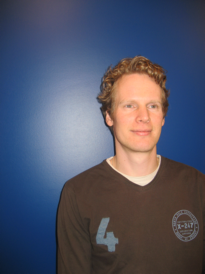An integrated three-dimensional sound-intensity probe
Promotion date: 3. October 2008
Promotor: Prof dr. Miko Elwenspoek, prof. Dr. Ir. W.F. Druyvesteyn
Assistant promotor: Dr. ir. R.J. Wiegerink
| Based on experiments with a manually assembled 3D-particle velocity probe, a chip with four integrated particle velocity sensors is developed. Furthermore a sound pressure sensitive device is developed for integration with particle velocity sensors on one chip. Integration of both sensors can easily be achieved with this design because the fabrication process is almost the same. The result is a fully integrated three dimensional sound intensity sensor that is very flat (1,3 mm instead of 7 mm). A two-dimensional particle velocity sensor with four sensor wires is invented. The use of a small connector with a sensor design, specially adapted to this connector, proves to be of great use. Application of the sensor in a commercial product has become feasible with a fast and reliable assembly method. |
What is special about the small “microphones” you studied in your thesis project?
These are so called particle velocity probes, a counterpart to normal microphones. In the form of two sensor wires they exist for about ten years already. The UT spin-off Microflown, now situated in Arnhem, sells these kinds of small microphones, mainly for advanced measuring processes in research projects.
By using four wires and an integration build-up of three particle velocity sensors, together with a sound pressure device, it appears feasible to trace sources of sound with a resolution of 1/10th of a millimetre.
Using particle velocity instead of the sound pressure signal, is often more suited to trace sound sources.
It was a job of great accuracy to characterize the sensor carefully: how sensitive it was tracing sound directions on a small scale, how to calibrate directionality and sensitivity, and how to fill in the application characteristics. Future applications can be found, for example, in ovens and engine exhaust systems.
After the thesis project, what are your plans for the future?
Now I work on a post-doc project, directly sponsored by the Microflown company. It involves topics raised, to make ‘my product’ more suitable for commercial applications. As I have much more knowledge than four years ago, and have more experience as a researcher, I feel I can contribute substantially to this.
I like to solve application-related research questions. Already in my thesis project, this was of some interest. In the device developed, I succeeded to construct a device with small sensor wires – two micrometers in width, and 1,5 mm long – to measure the 3D sound field. The sensor chip can be connected with a very fast mounting technique, making the production process far more efficient.
After the post-doc I am looking for a research job preferably at a company in the North of the Netherlands. The implied challenges are important to me. I like working on a product that is innovative, making things possible that are never realized before.
To stay successful, what is important for MESA+, in your opinion?
The cleanroom facilities are great, and the expertise to help you out is rightly available. In a way you are anonymous because of the cleanroom suit you are wearing all the time. Nevertheless you simply belong to the team, though you change colleagues regularly.
Sometimes it was a pity machines were not available for a longer period of time. Not only scientific researchers use the facilities at hand, so do spin-off companies. Sometimes you had to wait quite a long time until the reservation time had passed. To solve this is a matter of good planning, in my opinion.
All in all, you look back on a successful period?
Yes, it meant a lot to me. My teacher on the primary school will be especially stunned. As a child I was bored at school from time to time, busy doing other things than paying attention. He thought I was better off following a professional training in technique. Now I have come this far, I proved he was wrong.

